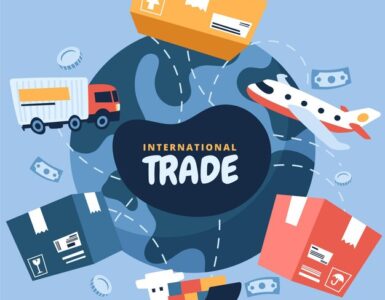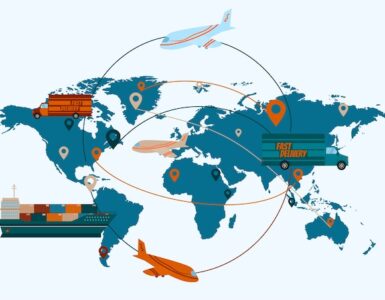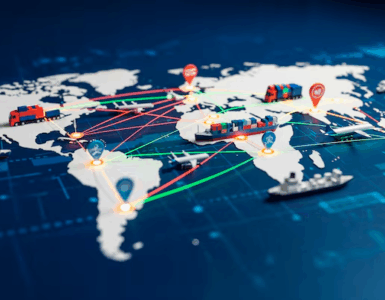If there is a point on which most economists agree, it is that trade among nations makes the world better off. Yet international trade can be one of the most contentious of political issues, both domestically and between governments.
When a firm or an individual buys a good or a service produced more cheaply abroad, living standards in both countries increase. There are other reasons consumers and firms buy abroad that also make them better off—the product may better fit their needs than similar domestic offerings or it may not be available domestically. In any case, the foreign producer also benefits by making more sales than it could selling solely in its own market and by earning foreign exchange (currency) that can be used by itself or others in the country to purchase foreign-made products.
Still, even if societies as a whole gain when countries trade, not every individual or company is better off. When a firm buys a foreign product because it is cheaper, it benefits—but the (more costly) domestic producer loses a sale. Usually, however, the buyer gains more than the domestic seller loses. Except in cases in which the costs of production do not include such social costs as pollution, the world is better off when countries import products that are produced more efficiently in other countries.
Those who perceive themselves to be affected adversely by foreign competition have long opposed international trade. Soon after economists such as Adam Smith and David Ricardo established the economic basis for free trade, British historian Thomas B. Macaulay was observing the practical problems governments face in deciding whether to embrace the concept: “Free trade, one of the greatest blessings which a government can confer on a people, is in almost every country unpopular.”

Two centuries later trade debates still resonate.
Why countries trade
In one of the most important concepts in economics, Ricardo observed that trade was driven by comparative rather than absolute costs (of producing a good). One country may be more productive than others in all goods, in the sense that it can produce any good using fewer inputs (such as capital and labor) than other countries require to produce the same good. Ricardo’s insight was that such a country would still benefit from trading according to its comparative advantage—exporting products in which its absolute advantage was greatest, and importing products in which its absolute advantage was comparatively less (even if still positive).
Though a country may be twice as productive as its trading partners in making clothing, if it is three times as productive in making steel or building airplanes, it will benefit from making and exporting these products and importing clothes. Its partner will gain by exporting clothes—in which it has a comparative but not absolute advantage—in exchange for these other products (see box). The notion of comparative advantage also extends beyond physical goods to trade in services—such as writing computer code or providing financial products.
Because of comparative advantage, trade raises the living standards of both countries. Douglas Irwin (2009) calls comparative advantage “good news” for economic development. “Even if a developing country lacks an absolute advantage in any field, it will always have a comparative advantage in the production of some goods,” and will trade profitably with advanced economies.
Differences in comparative advantage may arise for several reasons. In the early 20th century, Swedish economists Eli Heckscher and Bertil Ohlin identified the role of labor and capital, so-called factor endowments, as a determinant of advantage. The Heckscher-Ohlin proposition maintains that countries tend to export goods whose production uses intensively the factor of production that is relatively abundant in the country. Countries well endowed with capital—such as factories and machinery—should export capital-intensive products, while those well endowed with labor should export labor-intensive products. Economists today think that factor endowments matter, but that there are also other important influences on trade patterns (Baldwin, 2008).
Recent research finds that episodes of trade opening are followed by adjustment not only across industries, but within them as well. The increase in competition coming from foreign firms puts pressure on profits, forcing less efficient firms to contract and making room for more efficient firms. Expansion and new entry bring with them better technologies and new product varieties. Likely the most important is that trade enables greater selection across different types of goods (say refrigerators). This explains why there is a lot of intra-industry trade (for example, countries that export household refrigerators may import industrial coolers), which is something that the factor endowment approach does not encompass.
There are clear efficiency benefits from trade that results in more products—not only more of the same products, but greater product variety. For example, the United States imports four times as many varieties (such as different types of cars) as it did in the 1970s, while the number of countries supplying each good has doubled. An even greater benefit may be the more efficient investment spending that results from firms having access to a wider variety and quality of intermediate and capital inputs (think industrial optical lenses rather than cars). By enhancing overall investment and facilitating innovation, trade can bring sustained higher growth.
Indeed, economic models used to assess the impact of trade typically neglect influences involving technology transfer and pro-competitive forces such as the expansion of product varieties. That is because these influences are difficult to model, and results that do incorporate them are subject to greater uncertainty. Where this has been done, however, researchers have concluded that the benefits of trade reforms—such as reducing tariffs and other nontariff barriers to trade—are much larger than suggested by conventional models.
Why trade reform is difficult
Trade contributes to global efficiency. When a country opens up to trade, capital and labor shift toward industries in which they are used more efficiently. That movement provides society a higher level of economic welfare. However, these effects are only part of the story.
Trade also brings dislocation to those firms and industries that cannot cut it. Firms that face difficult adjustment because of more efficient foreign producers often lobby against trade. So do their workers. They often seek barriers such as import taxes (called tariffs) and quotas to raise the price or limit the availability of imports. Processors may try to restrict the exportation of raw materials to depress artificially the price of their own inputs. By contrast, the benefits of trade are spread diffusely and its beneficiaries often do not recognize how trade benefits them. As a result, opponents are often quite effective in discussions about trade.
Trade policies
Reforms since World War II have substantially reduced government-imposed trade barriers. But policies to protect domestic industries vary. Tariffs are much higher in certain sectors (such as agriculture and clothing) and among certain country groups (such as less developed countries) than in others. Many countries have substantial barriers to trade in services in areas such as transportation, communications, and, often, the financial sector, while others have policies that welcome foreign competition.
Moreover, trade barriers affect some countries more than others. Often hardest hit are less developed countries, whose exports are concentrated in low-skill, labor-intensive products that industrialized countries often protect. The United States, for example, is reported to collect about 15 cents in tariff revenue for each $1 of imports from Bangladesh (Elliott, 2009), compared with one cent for each $1 of imports from some major western European countries. Yet imports of a particular product from Bangladesh face the same or lower tariffs than do similarly classified products imported from western Europe. Although the tariffs on Bangladesh items in the United States may be a dramatic example, World Bank economists calculated that exporters from low-income countries face barriers on average half again greater than those faced by the exports of major industrialized countries (Kee, Nicita, and Olarreaga, 2006).
The World Trade Organization (WTO) referees international trade. Agreements devised since 1948 by its 153 members (of the WTO and its predecessor General Agreement on Trade and Tariffs) promote nondiscrimination and facilitate further liberalization in nearly all areas of commerce, including tariffs, subsidies, customs valuation and procedures, trade and investment in service sectors, and intellectual property. Commitments under these agreements are enforced through a powerful and carefully crafted dispute settlement process.
Under the rules-based international trading system centered in the WTO, trade policies have become more stable, more transparent, and more open. And the WTO is a key reason why the global financial crisis did not spark widespread protectionism. However, as seen most recently with the Doha Round of WTO trade negotiations, the institution faces big challenges in reaching agreements to open global trade further. Despite successes, restrictive and discriminatory trade policies remain common. Addressing them could yield hundreds of billions of dollars in annual global benefits. But narrow interests have sought to delay and dilute further multilateral reforms. A focus on the greater good, together with ways to help the relatively few that may be adversely affected, can help to deliver a fairer and economically more sensible trading system.
[“source=imf”]





















































